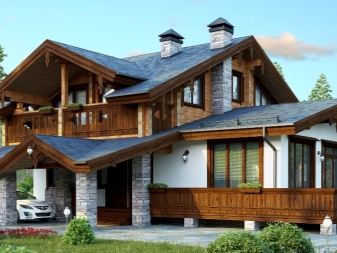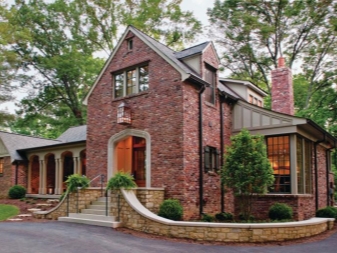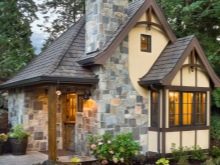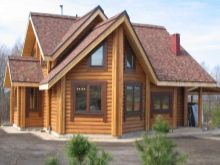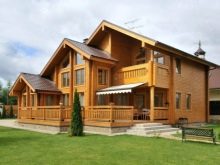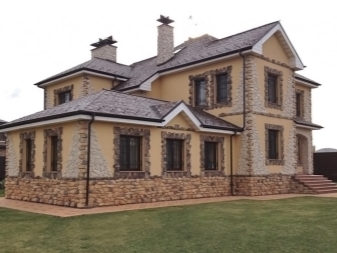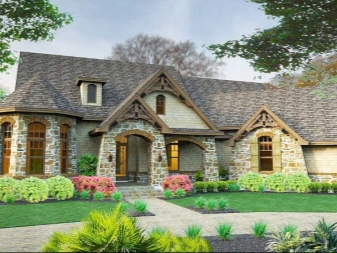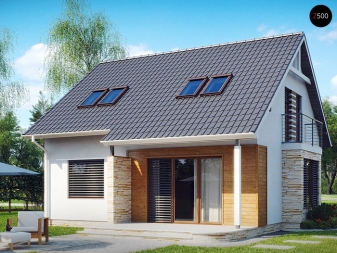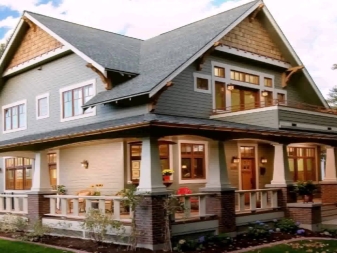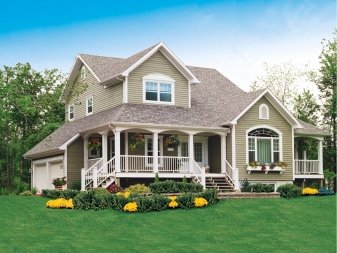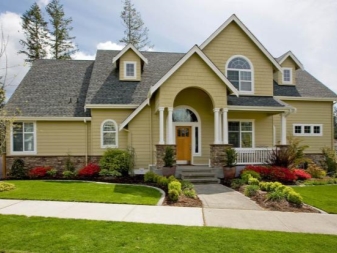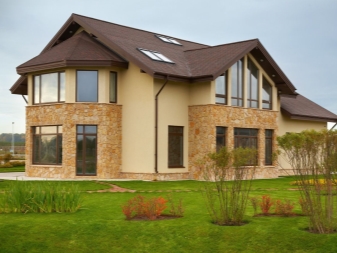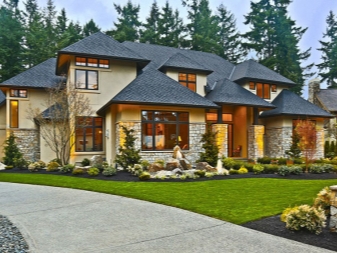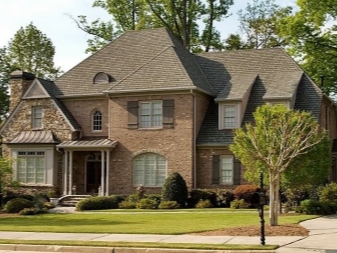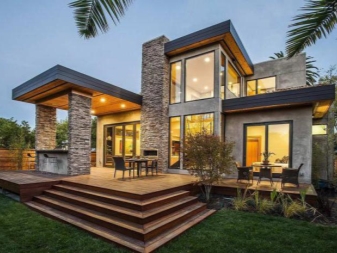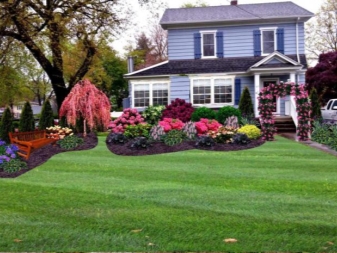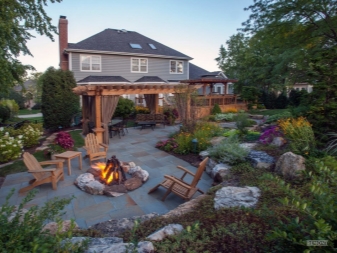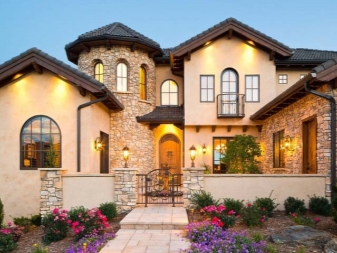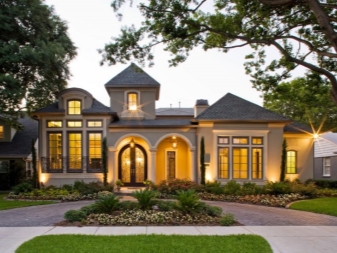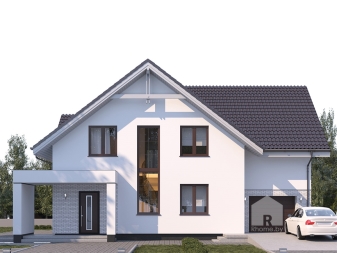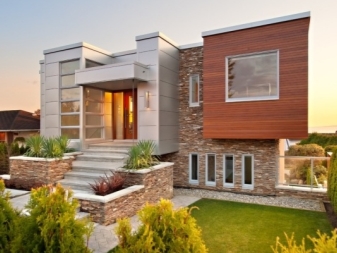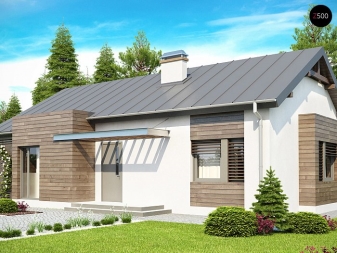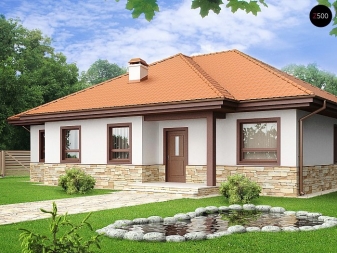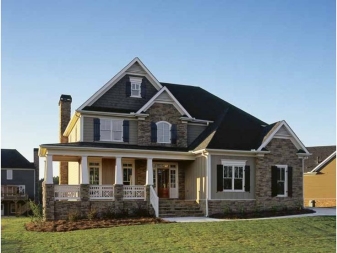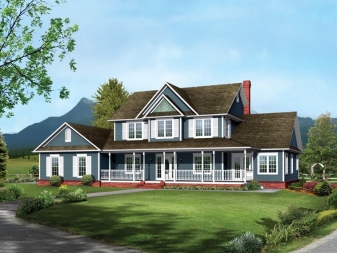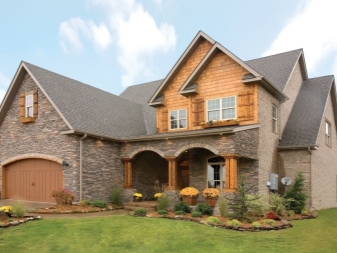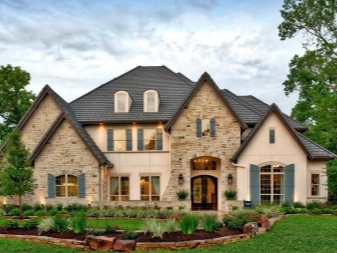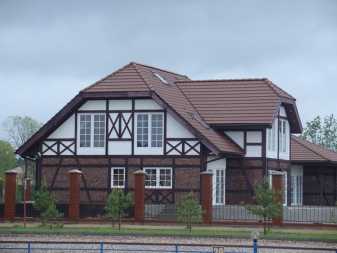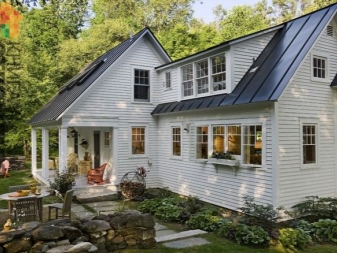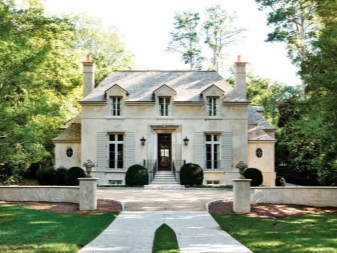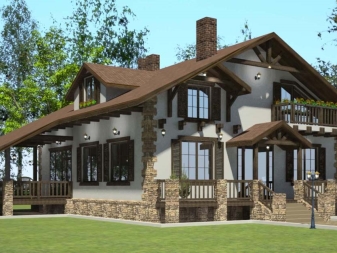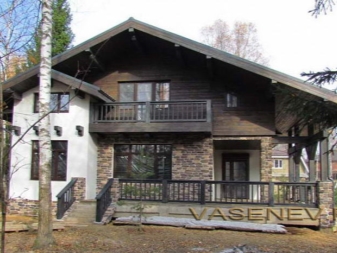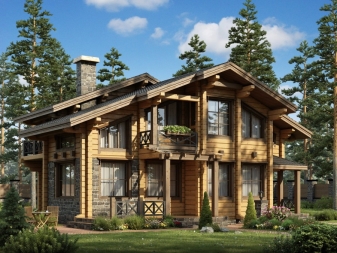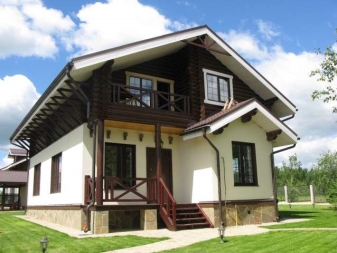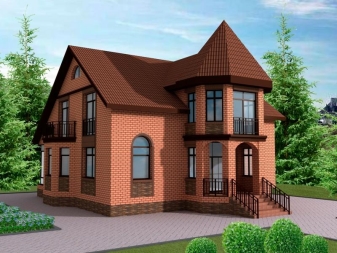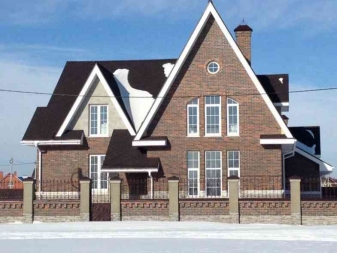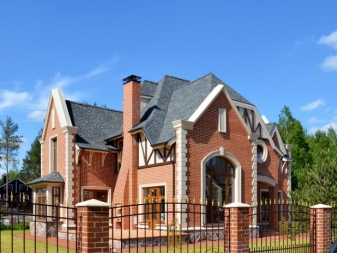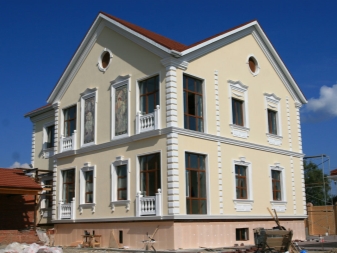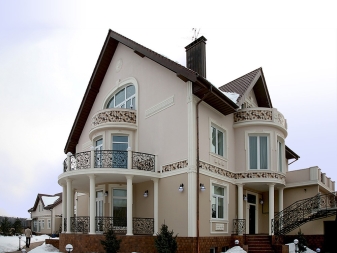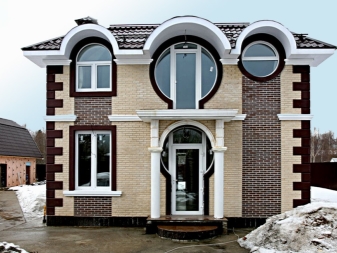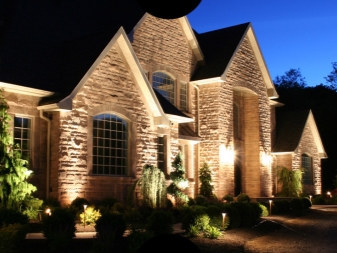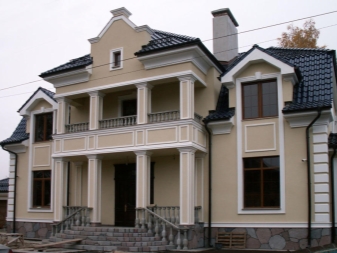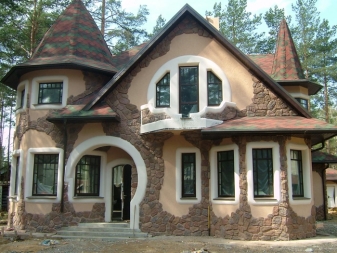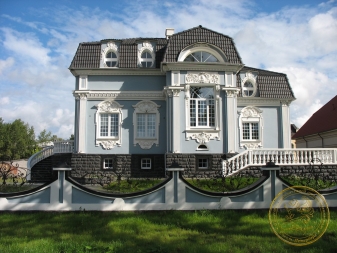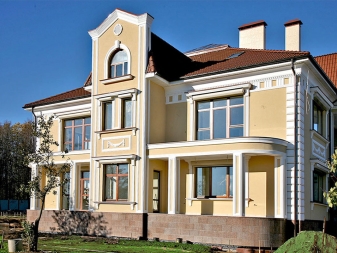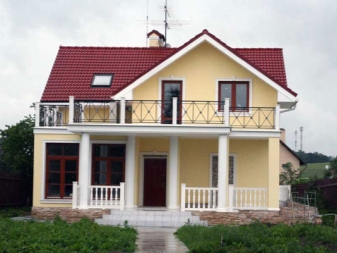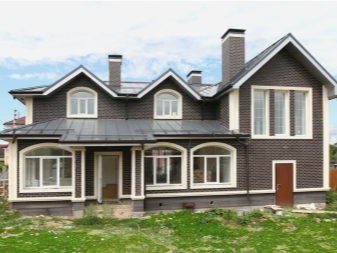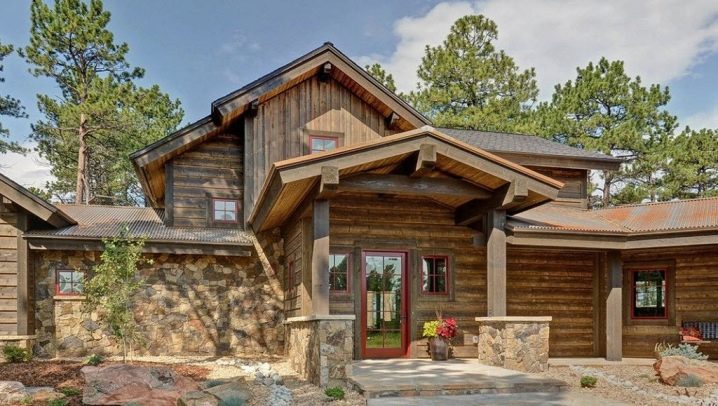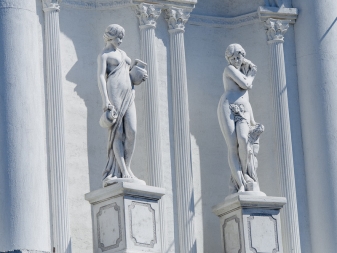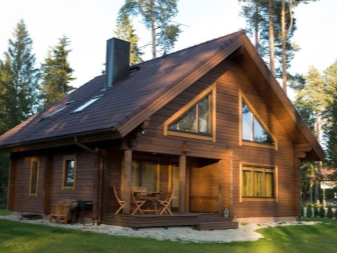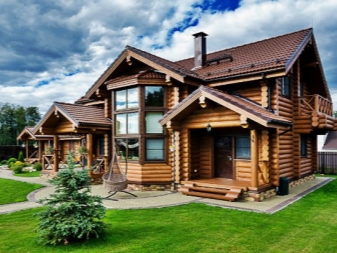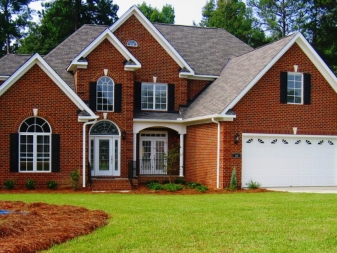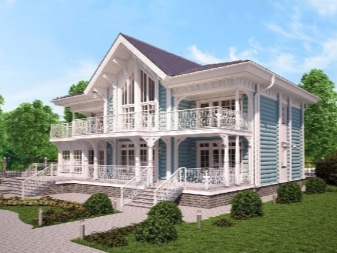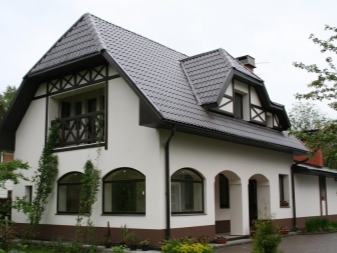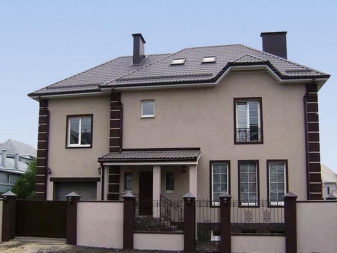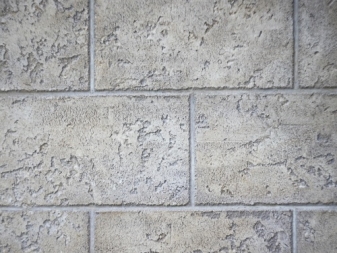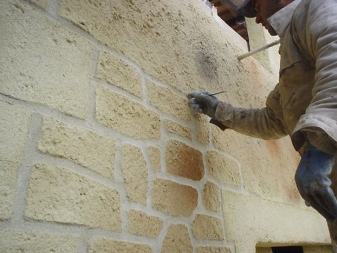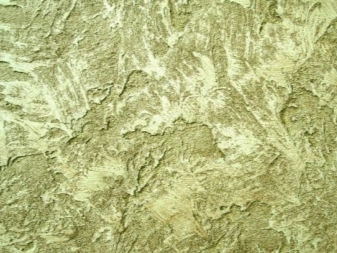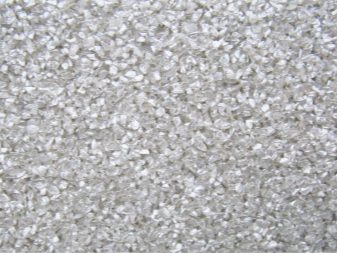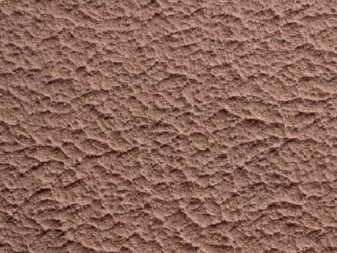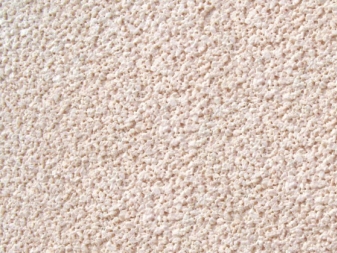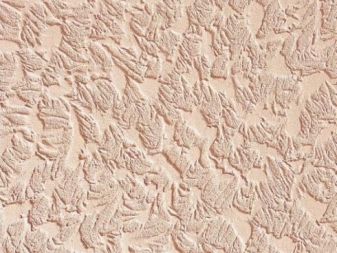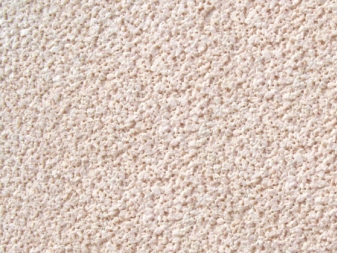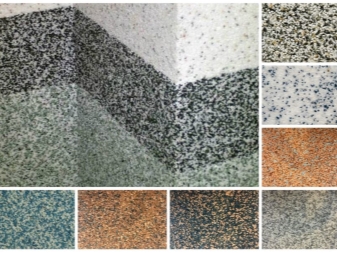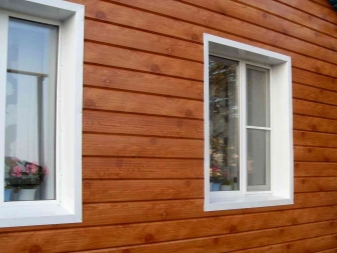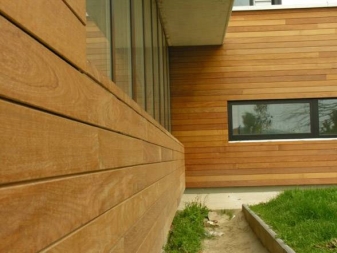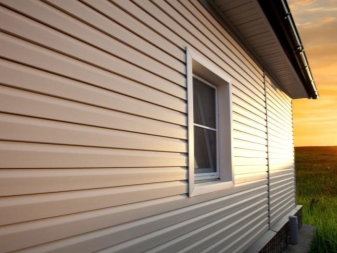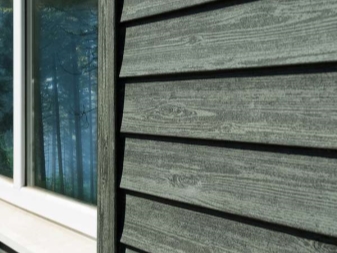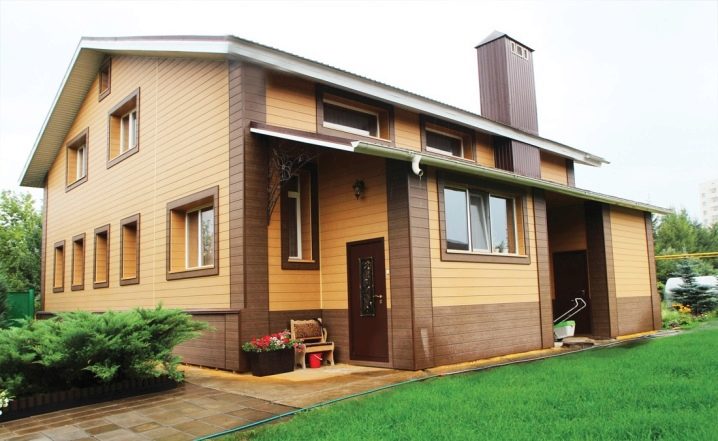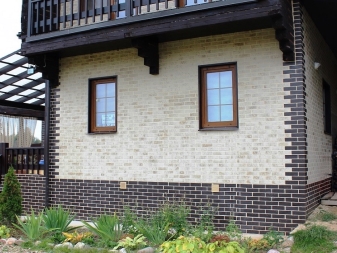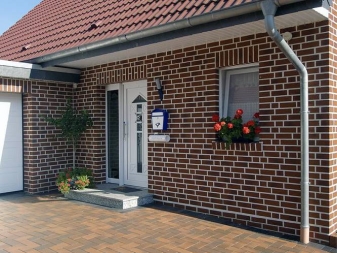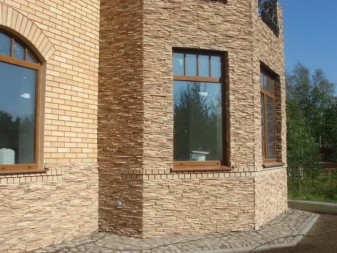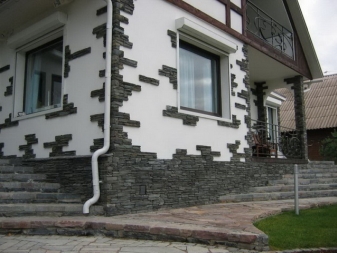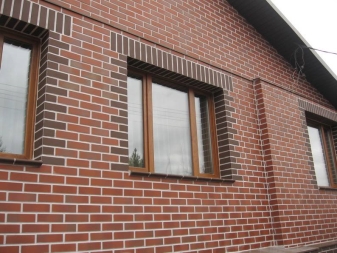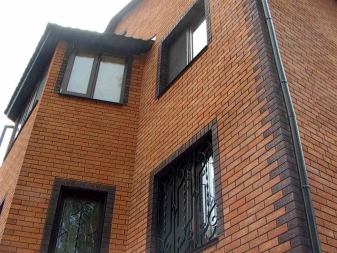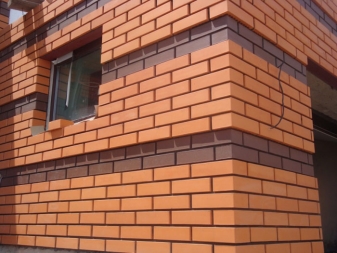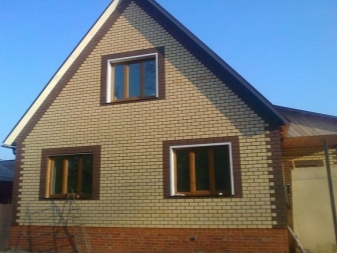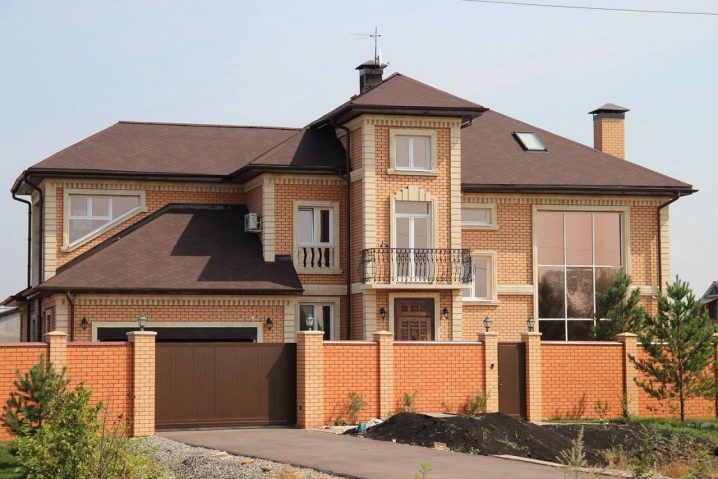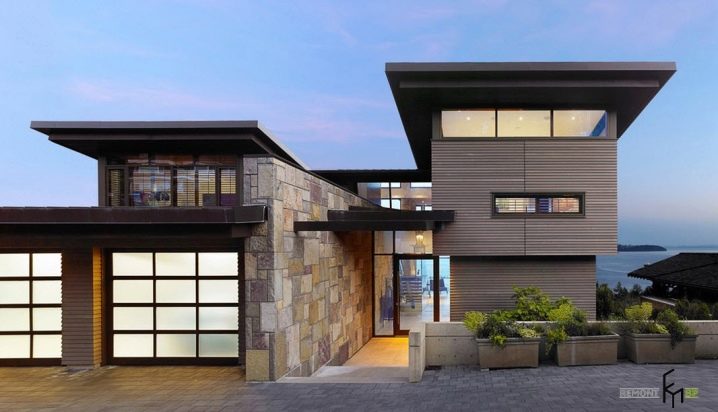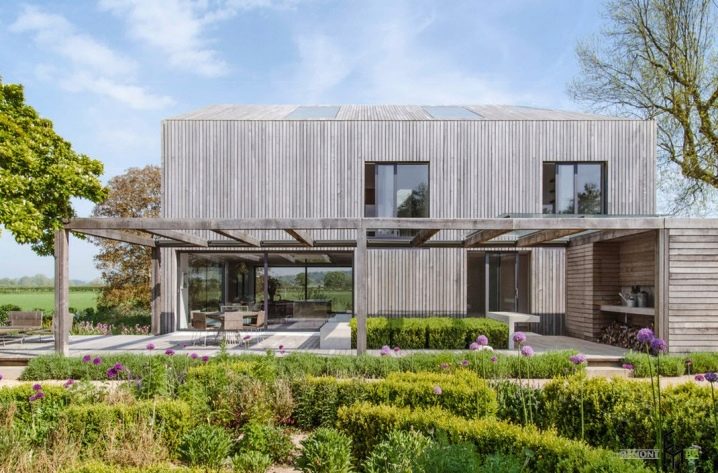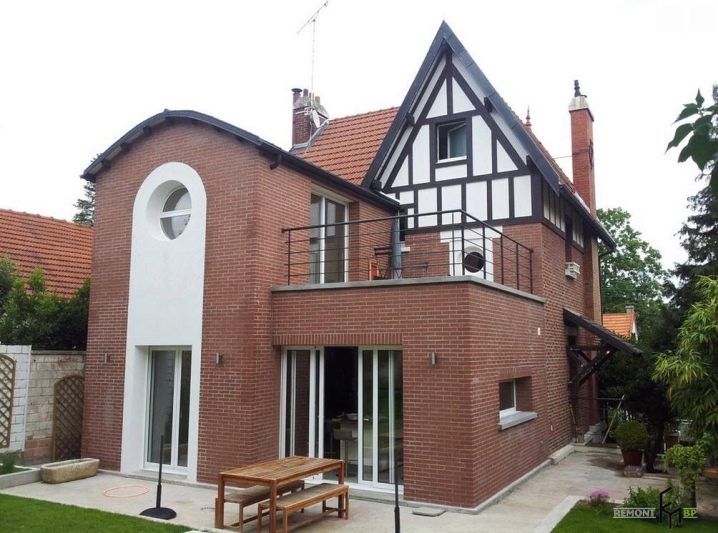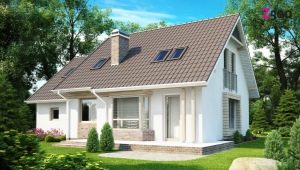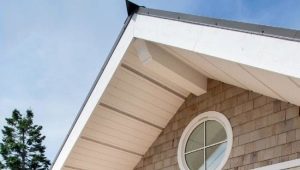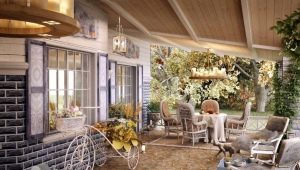Features of the design of houses outside
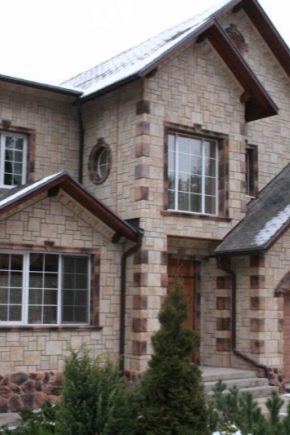
The selection of finishing materials start already in the drafting of the building. Along with the decorative component, their strength, insulating characteristics, anti-corrosion, flame retardant properties, resistance to temperature leaps and other adverse effects are evaluated. In some cases, if required, styling is carried out after the construction of the walls. Questions of a combination of technological and aesthetic moments and are discussed in this article. It also provides a general overview of building materials and several style solutions for a country house.
Special features
Looking through real estate catalogs or comparing different projects with each other, we often talk about the architectural attire of a house.Such a comparison of the facade with the clothing of a person is not accidental. Like clothing, the outer shell of the building protects against weathering and at the same time serves as a clear indication of the status, tastes and preferences of the owners.
Maintaining a sustainable internal microclimate and creating a bright aesthetic image - both of these tasks in front design should be solved on an equal footing.
As in the ability to dress stylishly, there is nothing insignificant in the design of the building.
The style consists of a strictly aligned component chain:
- color sets the mental attitude already at the first, very quick glance at the building;
- the type and texture of the materials used in the decoration allow to avoid monotony and at the same time are recognizable attributes of a particular style;
- decorative elements allow you to build a harmonious whole.
The peculiarity of the outdoor design is that these components should be in unity not only with each other (and, by the way, with the interior), but also with the “context”: the natural area, local landscape, garden plot and neighboring houses (if they are available).
Each era and tradition offers the best and time-tested.Fakhverk draws attention to beamed lace, Provence - light, fawn tones, chalet - comfort, and classicism - versatility. A steady trend in recent years is a mixture of architectural styles and trends.
However, if you do not take into account the climatic realities, as well as regional features, any advantages may be out of place. For example, balconies and open terraces of the Mediterranean style will simply not be in demand in the cold northern areas. An elegant Empire will be difficult to conquer the visual space among the pines and Finnish houses.
Absolutely everything around the building, including benches and a fence, should work on the “image” of the main building. Clear, rectangular contours of the garage and outbuildings are well suited for high-tech style, but not for the chalet. The material that paved the track, no less important than the cladding of the facade. Ivy-covered gazebos, flower beds, alpine slides, sculptures, artificial reservoirs - we perceive all this in indissoluble unity with the house and, therefore, all this must be worked out at the design stage.
Outside of a private house you need to make a facade only with quality materials.
This will help you to avoid frequent repairs of the facade, and it will serve you for many years.
Variants of the facade
There are up to one and a half dozens of main styles only, each of them is represented by several varieties, so that even a cursory review of one article cannot be done. Consider just a few stylistic options for country houses, in the center of the forest or on the lake, in a word, for country house-building.
Single story
Classic. Interest in classic style development has never faded. Summer house can be made in the classics. Few styles can argue with the neatness of the external decoration, with emphasized clear proportions of windows and capitals, a combination of a certain amount of minimalism with a wealth of individual elements (for example, stairs, columns, decorative arches). The simplicity of this kind speaks of prosperity and reasonable self-restraint, thereby stating the status of the owner.
Two-story
Country and its varieties. As the name implies, this trend bribes us with completely different than the classic features. In a broad sense, the country includes both French Provence, and American “West”, and designs based on the style of the Russian village, and the chalet, which came to us from the Alps.That is, this is a multinational trend that unites a lot of things that could be characterized by the word "remote". It is not recommended to mix different types of this style, because then the ethnic identity is lost.
Country style is good for cottages amid mountains or woods. Natural materials - wood and raw stone - look perfectly organic. At the same time, it is not necessary to use a real stone, this makes the building's structure heavier. Now there are a lot of lightweight artificial materials, which, however, are increasingly difficult to distinguish from the "original".
Varieties:
- Provence - This is a remote place, but devoid of wildness. It is distinguished from traditional country by a range of light, coldish, but very refined shades, among which pure white color dominates. This French style was loved by many for the light decor of balconies and gables, windows divided into sections and painted white as snow.
True, finishing materials in the style of a genuine, “reliable” Provence can cause significant damage to the budget. Therefore, an option that offers a mixture of materials.So, natural stone can be spent on the basement level, and finish the walls with siding.
The stone of warm tones, characteristic of this style, will harmonize well with the landscape.
- Chalet - The style is the most "secluded" and touching. Once it emerged as the usual way of “shaping” the unsophisticated dwellings of shepherds, and is now in demand all over the world, and for implementation requires a lot of money and a thoughtful approach on the part of designers and designers.
Painting the exterior of a frame house with a loft should be in your chosen style. It is necessary to pay close attention to painting the corners. They can be highlighted in contrasting colors.
Decorative solutions
Interesting options for facades:
- Rust, i.e. raw stone (or imitation) - this is primarily an option for facing the basement, but is also used for columns and arches.
- Window and door openings The first to meet the visitor's eyes, and their framing should be well thought out. Above the window there can be sandrik, that is, a small cornice, of a straight, triangular or luchkovoy shape. Slopes and window sills are surrounded by stucco or molding.
- Columns - one of the classic elements - can, in addition to carrying a constructive function, serve as decoration for the entrance group (main entrance). Columns and pilasters are used to divide a solid wall space into separate zones.
- Arches will decorate any part of the building.
- Cornice, in addition to the utilitarian function (to protect walls from precipitation), plays a huge role in shaping the appearance of the facade. The decoration is mounted at the junction between the wall and the binder of the roof and decorated, in accordance with the chosen style. For a multi-storey building, it is appropriate to highlight a cornice in the evening.
- Corner elements serve as a framing facade. The white rectangles version is still used, but new options are emerging: imitation of a torn stone, geometrically free design, and so on.
- Fretwork in a well-thought-out project, it can revive arches, openings, balustrades, play a special role in decorating windows. Special paints, wax and patina can create an effect of artificial "aging", which will give certainty to some traditional styles.
- Molding - These are ready-made overhead parts.Rectangular molding, that is, long strips of contrasting color, is able to actively interact with the area of the facade wall, structuring it in one way or another. Molding décor is also used, for example, a flat wall can be decorated with an overhead frame with a floral ornament in the middle.
For some styles, wood molding is preferable.
- Niches for a vase or statue can be framed with a frame with a pattern, stucco, columns, pilasters. The option of an empty highlighted niche is possible.
- You can add that on sale there are finished products made of polystyrene foam coated with acrylic, having ample strength and complete similarity with natural materials.
- Imitation timber suitable as a decorative element. You can also choose painted timber. Mosaic can be distinguished individual elements of the facade.
Materials
For the exterior and, in particular, the front side of the house, almost all types of traditional mineral as well as modern synthetic materials are used.
Here are some of them:
Decorative facade plasters
Not to be confused with ordinary ones. The class of the most accessible and sought-after materials for decoration.The prepared aqueous solutions are applied with a relatively thin layer (from 5 mm), which, while freezing, forms a durable, and in some cases a colorful coating. In addition to the aesthetic, plaster perform the functions of heat saving (often “in one bundle” with wall insulation), sound insulation, protect the facade from the weather and damage. All of them are resistant to ultraviolet radiation.
Granite and marble chips, as well as mica, anthracite, glass, quartz and many other materials are used as a decorative filler. Facade plasters are characterized by the type and size of the filler, according to the technology applied to the wall, the method of painting.
First of all, they are distinguished by the type of binder:
- Silicate. Mineral fillers provide decorative mass, and liquid glass acts as a binder here. The material is not elastic, however, it has high vapor permeability and is able to stay clean for a long time.
For sale silicate plaster is ready to use. It is used on the coquina, cellular types of concrete and other porous and difficult-to-work surfaces. The disadvantages include the appearance of small cracks.For the price - this is one of the most expensive materials.
- Acrylic. Due to its elasticity and moisture resistance, this plaster is widely used precisely in the finishing of facades. Thanks to acrylic, the coating is immune to vibration (can be used near motorways) and temperature fluctuations. Acrylic plaster easily collects dust and dirt, however, it can be washed.
At the same time, the addition of polymer has a negative side: the coating does not “breathe” so that, if there is a heater, it can begin to collect moisture.
- Silicone. It combines almost all the advantages of other materials and therefore belongs to the most expensive class. It is elastic, interferes with the growth of colonies of microorganisms, has good vapor permeability and is not polluted. A variety of fillers give it a highly aesthetic look.
- Mineral This plaster is probably the closest to normal, because it contains portland cement and lime, however, here they are supplemented with chemical additives. The result is a durable coating that gets stronger over the years. The filler is a crumb of granite, marble, quartz, which gives the coating additional reinforcing properties.
Mineral plaster has good vapor permeability, is not afraid of exposure to water and, importantly, relatively inexpensive. At the same time, you should not use it for homes near the road: constant vibration can accelerate the formation of cracks.
Siding
Its history dates back to the 19th century, when wooden siding boards nailed horizontally so that rainwater rolled down.
Varieties:
- Woody. It is a compressed mixture of wood fibers and polypropylene. The material is moisture resistant, fire resistant and has a decent service life (15 years), during which it is not necessary to impregnate or paint it.
- Wooden. It uses either hardwood or impregnated wood (i.e., impregnated with special antiseptics), or heat treated at 170-220 ° C, after which the tree becomes resistant to adverse effects and destructive insect activity.
- Vinyl. This material breaks all practicality records: in two or three decades, it will look like on the day of purchase. The composition (in addition to the polyvinyl chloride) includes a number of additives that imply resilience, elasticity, lasting color shade.The lined wall is not afraid of corrosion, rotting, heavy rains or the most severe (up to? 50 ° C) frost.
You can wash it, just pouring water. Since products from polymers are often accompanied by vague concerns, it should be said about environmental friendliness: the material is flame-resistant, does not contain any toxic substances, and does not conduct current.
Like other types, PVC siding belongs to ventilated cladding systems: due to the special design, condensate is discharged without causing harm to the inner layers of the house's cladding.
Tile
Tiling is quite traditional in technology, however, its decorative possibilities are far from being exhausted. Every year new models of this material appear, erasing the line between tile and torn stone, tile and decorative brick. The most “coarse” (rustic) species are appropriate at the bottom, on the basement part, and smaller ones - at the top of the building. Large-sized plates of porcelain will be quite appropriate in industrial styles.
It is necessary to strictly observe the time limits prescribed by the technology for shrinking and drying the walls, otherwise elegant "clothes" at home will very quickly require a patch.When laying tiles on terraces, and especially vertical surfaces, you should use reinforced adhesive mixtures for harsh environments. It is not enough to choose a trowel for the joints by color - it must be of the highest quality. The fact is that in winter the moisture penetrated under the tile will freeze and will begin to tear it from the base.
Brick
If the decorative brickwork was envisaged by the project, then all that is needed is to take care that there is no efflorescence (for this there are special additives). However, in some cases, the idea to use this ancient building material arises along with the desire to update the facade of the old building. In this situation, it is possible to arrange a ventilated facade system, that is, to provide a stream of air that will remove condensate. So you can protect old wood or stone from fungus and mold.
Brick belongs to the oldest building materials and is associated with good quality and healthy patriarchal nature. That is how it looks in the English style. Clinker brick is no stranger to respectability.
Polyurethane panels can perfectly decorate the facade of the house.Polyfoam will help also to warm the house. The stucco element will highlight certain parts of the facade.
To delve into the theme of facade design, it takes time.
But as a result, the house will be a continuation of the look of the owner, and not a beautiful thing, but taken from the hands of others.
Interesting ideas and examples.
For a private house this style of the facade as country music is perfect. It can be complemented with other styles. For example, half-timbered or European. This will help make your home stylish and individual.
Modern designers propose to apply this style of the facade of a private house, as minimalism. In this style you can meet strict geometric lines and a minimum of decorative elements. If you do not like overloaded facades, then minimalism will suit you perfectly.
Modern is the style of Hi-Tech. In this style, you will be able to fully express their imagination. The main thing is to use only modern building materials.
On how to choose the color of the facade without the help of a designer, see the following video.
